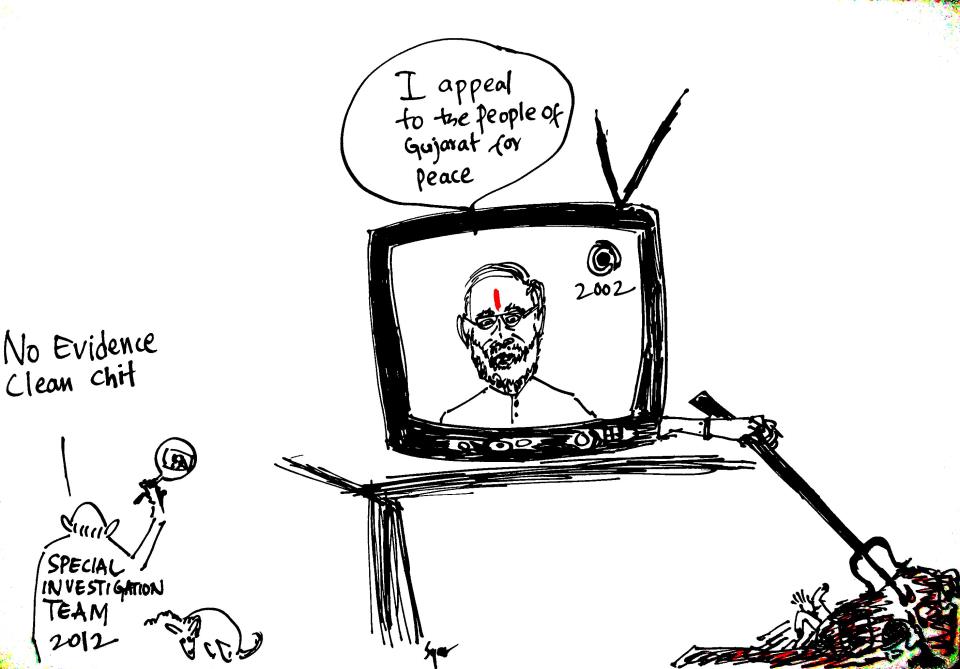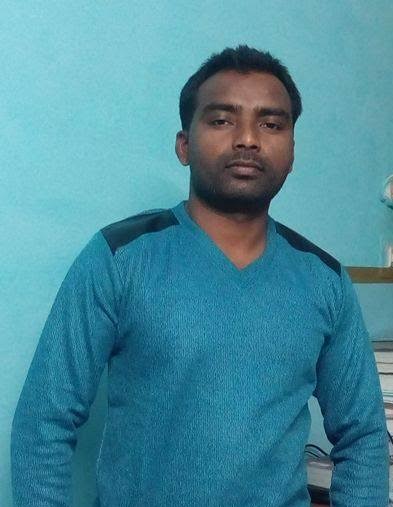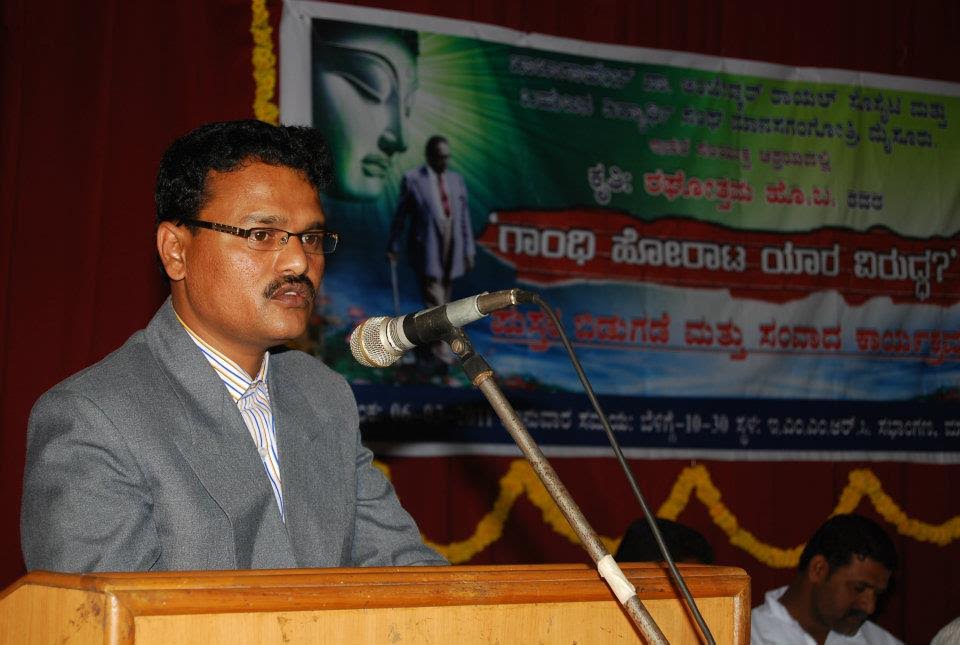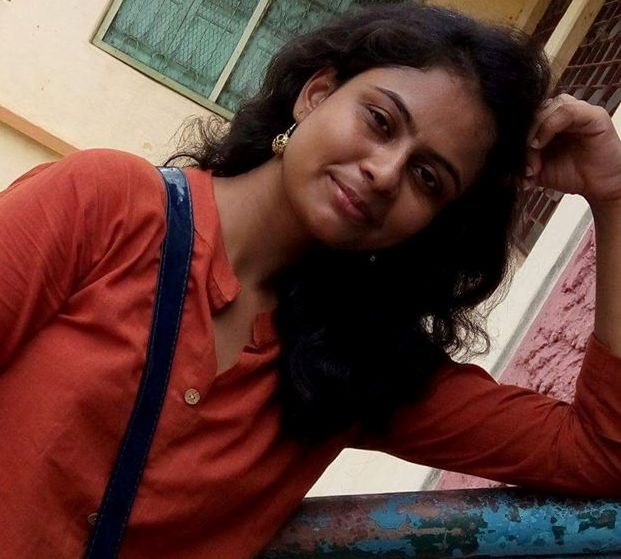N. Sukumar and Shailaja Menon
While driving past the Delhi police headquarters we happened to see a huge mural of Gandhi on the building walls when it suddenly struck us that the ideology which assassinated Gandhi is now controlling the national imagination. One may have differences with Gandhi’s beliefs but when political murder is justified under the garb of imagined grievances, some soul searching is required. It is indeed laudable that a person of humble origins is occupying the highest position in the nation, a triumph of democracy: but will the huge mandate wipe away the stains of 2002, when he failed to perform his ‘rajdharma’.

The massive manufactured mandate brings to mind Ambedkar’s warning regarding the tendency of Indians to hero worship1. He was immensely concerned over the political culture of “laying down the liberties at the feet of great men or to trust them with powers which enable them to subvert their institutions.” He believed that there is nothing wrong in being grateful to great men who have rendered life-long services to the country. But there are limits to gratefulness. No man can be grateful at the cost of his honour, and no nation can be grateful at the cost of its liberty. This caution is far more necessary in the case of the people of India than in the case of any other country, for in India, bhakti, or what may be called the path of devotion or hero-worship, plays a part in politics, unequalled in magnitude to the part it plays in the politics of any other country in the world, argued Dr. Ambedkar. He went on to add that bhakti or hero-worship in religion may be a road to the salvation of the soul, but in politics, bhakti or hero-worship is a sure road to degradation and to eventual dictatorship.
Swept away by the tumult of 2014, it is easy to jump to the conclusion that caste has fallen by the wayside under the Modi juggernaut. Reading against the grain leads one to a more nuanced understanding of the manner by which caste was skillfully incorporated into the election campaign. Addressing his first election rally in Kerala, Modi pitched for a third alternative against the two major political alliances in the state which according to him failed to attend to the concerns of the Dalits, backward castes and tribals. He wanted to debunk the Ranganath Misra Commission’s report2 on reservation for minorities3. Evidently, a rift is created by pitching different marginalized dalit and tribal groups against one another. The political message was that the BJP has no issue with the hinduised dalits and tribals enjoying the fruits of reservation but it should not be made available to the Muslims and other minorities and to the scheduled castes converting to other religions. This would be anathema to the interests of the ‘Hindu Undivided Family’.
On April 14 2014, Modi garlanded Ambedkar’s statue and then addressed the second 3D rally for the Lok Sabha campaign. The political contingencies forced the RSS to install Ambedkar as a part of its pantheon of deities. The continuous attempt of the RSS ideologues to appropriate Ambedkar is reflected in their strategies. To illustrate, Centre Right India4 – an online forum – seeks to forge a unity between Ambedkar’s ideas and the RSS. The language is very persuasive, mesmerizing and speaks of social and religious brotherhood. It reflects the politics of accommodation since the BJP needs the Dalit and tribal votes to attain a political majority for cultural consolidation. For the first time in independent India, the Muslims are conspicuous by their absence amongst the BJP’s 282 victors. It is a pyrrhic victory if the minorities tremble in fear recalling the Social Darwinism of 2002. Jan Bremen5 has analyzed the well-entrenched nature of the Hindutva movement and its predecessors in Gujarat, strongly opposed to communal harmony and to the design of society as a melting pot of diverse and open-ended social segments. The mobilisation of low and intermediate castes to participate in the activities of the Sangh parivar organisations in the last two decades has broadened the base of Hindu fundamentalism as a social-political force. The price these previously denigrated segments have to pay for their acceptance within the Hindutva fold is their willingness to express antagonism to Muslims as members of the religious minority and, in brutal acts of confrontation, to do the dirty work of cleansing on behalf of their high caste brothers and sisters. The dynamics of inclusion and exclusion are intricately interwoven6.
Hence, caste dynamics is an escapable part of the political landscape. However, one needs to accept the fact that the alternative political ideologies ceded space to Moditva even before the battle commenced by refusing to read the writing on the wall. The Indian National Congress paid for its dynastic arrogance when it took the Muslims and dalits for granted and believed in the TINA factor. However, one of the most curious stories from the 2014 Lok Sabha polls will be that of the BSP, which, despite getting the third-highest vote share of just over four per cent, did not win a single seat. The party had 21 seats in the 15th Lok Sabha, 20 of which were from UP. As per data available at the time of filing this report, the BSP polled 2.29 crore votes and had a vote share of 4.2 per cent. After the BJP, whose vote share hovered around 31.1 per cent and the Congress, which had a vote share of 19.4 per cent, the BSP emerged as the third highest vote-getter in the country. But these votes were not good enough to win the party even a single seat in the 16th Lok Sabha7.
How does one explain the fact that the share of votes increased but did not translate into a single seat? One factor is the hijacking of the agenda of good governance by the BJP and AAP. In addition, there was a visible lack of a dedicated cadre to spread the message of social transformation. This is the sine qua non of Dalit politics which has been undermined by political formations which stress on good governance and corruption. Will these concepts address the ‘unfreedoms’ of dalits and minorities of all hues oppressed by the cultural hegemony of majoritarianism? The state of Haryana performs extremely well on the development indicators but it has also earned the dubious tag of being the most feudal and casteist region. Over two dozen Dalit girls and women have been raped over just one month (September-October 2012) in Haryana, going by the State Crime Records Bureau’s records for cases filed. All of these have involved charges under the IPC for rape, with the SC/ST Act invoked in certain cases8. Will good governance and development ensure justice to the victims of Bhagana?

The co-option of Dalit ideologues by the BJP reflects the lack of coherent vision among the Dalit political leadership who are satisfied with the crumbs of office instead of working for a structural/social transformation. The personality cult operating amongst the Dalit groups forecloses any attempt at alliance building and generates mistrust. Further, they do not welcome any dissent. The template of the Left political agenda maintained a studied silence on the issue of caste. Thus, they could never form alliances with any other political formations. On the contrary, despite the internal contradictions, the BJP fought the elections with a collective vision of leadership. They were aided by the corporate moneybags and the skillful use of the social media to undermine any ideological opposition both within and outside the party. The RSS cadres labored hard to influence the voters especially in regions which did not have strong regional political formations.
The competition is extremely tough in the market place of ideas and the medium is the message. It is tremendously significant to introspect on the vacuous political leadership of the Dalit and Left groups. The Congress needs to think beyond the family to resurrect its fortunes. One needs to focus on the underbelly of development and revive the inclusive idea of India. The battle lines have been drawn and the first salvo against freedom of expression has been fired. The RSS has stated that it opposes gay rights. And the Prime Minister designate is a committed worker of the RSS9. From the Buddha to Gandhi, Indian society has engaged with the notion of non-violence, but the harsh reality is that the nation has gone into the hands of people who believe in violence. It is really poetic justice when Modi as the Prime Minister of India will pay his homage at Rajghat on 2nd October. An uneasy calm prevails across the country as a million mutinies ebb and flow to strive to fulfill Articles 38 and 39 of the constitution that upholds the vision of an inclusive, egalitarian and just society. Nehru’s tryst with destiny and Ambedkar’s dream of social democracy have been deliberately sidelined in the mindless pursuit of crony capitalism. In passing, we can only echo Tagore’s fervent plea, “Into that heaven of freedom, let my country awake”.
~
Notes
[1] Clause wise Discussion on the Draft Constitution PART III November 17, 1949 to November 26, 1949, Section Eight, Third Reading of the Draft Constitution http://www.ambedkar.org/ambcd/63F2.Third%20Reading%20of%20Draft%20Const17.11.1949%20to%2026.11.1949.htm, Accessed on 19/05/2014, 11.50 pm
[2] The government-appointed Justice Rangnath Commission has recommended 10% reservation for Muslims and 5% for other minorities in government jobs and favoured Scheduled Caste status for Dalits in all religions.
[3] http://www.thehindu.com/news/national/modi-pitches-bjp-as-third-alternative-in-kerala/article5670511.ece, Accessed on 17/05/2014, 11 pm
[4] Aravindan Neelakandan / in featured, longform / April 30, 2012, Bodhi Sattva’s Hindutva: Part 6, Accessed on 19/05/2014, 11.15 pm
[5] Jan Bremen, Communal Upheaval as Resurgence of Social Darwinism, www.epw.org, accessed on 17/05/2014, 11.30 pm
[6] For Further details refer, Communalism as a Political Strategy, http://www.hrw.org/reports/2003/india0703/Gujarat-10.htm, Accessed on 20/05/2014, 12.15 am
[7] http://indianexpress.com/article/india/india-others/bsp-gets-third-highest-vote-share-but-no-seats/Accessed on 17/05/2014, 12. am
[8] http://www.indianexpress.com/news/in-haryana-more-and-more-rapes-every-year-few-convictions-for-crimes-against-dalits/1013752/, Accessed 28/08/2013, 11.15 pm
[9] http://lgbtweekly.com/2014/05/19/india%E2%80%99s-anti-gay-hindu-nationalist-party-voted-to-power/Accessed on 19/05/2014, 11.20 pm
~~~
N. Sukumar teaches Political Science at Delhi University. (suku69@yahoo.com)
Shailaja Menon teaches History at the School of Liberal Studies, Ambedkar University, Delhi.
(shailaja@aud.ac.in)
Cartoons by Unnamati Syama Sundar.










